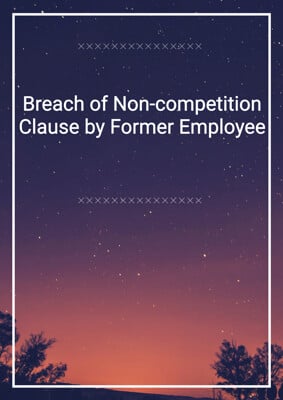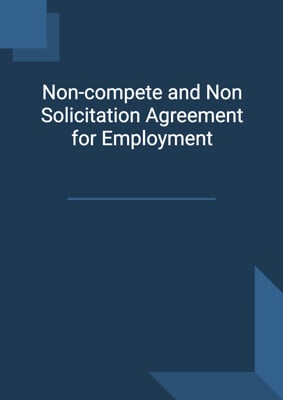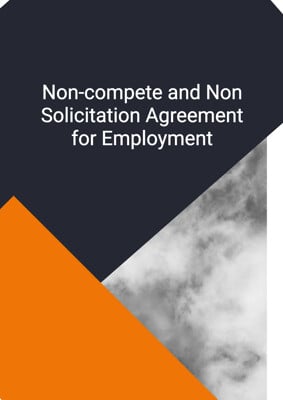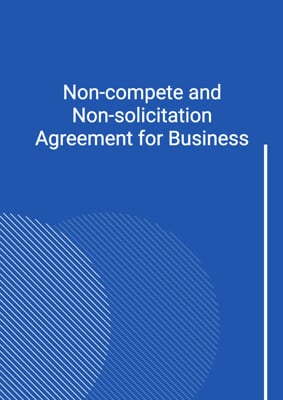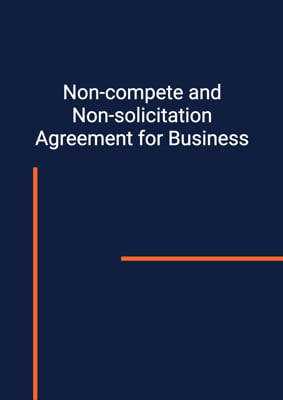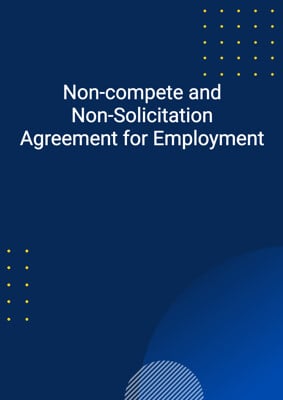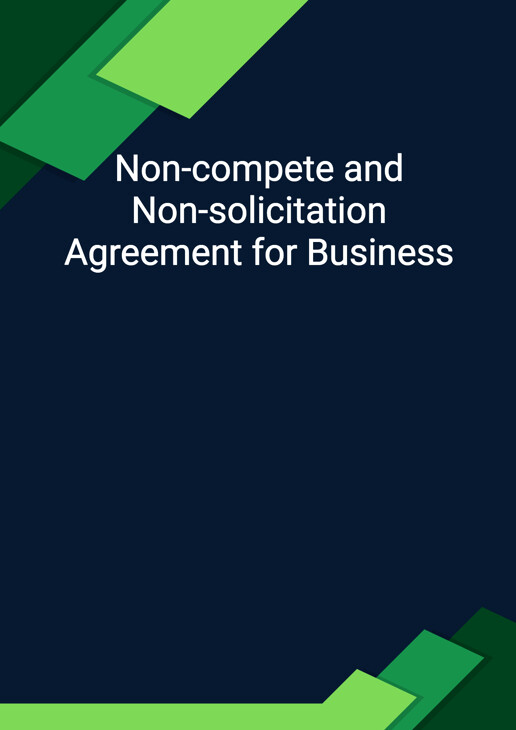
Non-compete and Non-solicitation Agreement for Business
Loose / Light
One way Non Compete and Non Solicitation agreement for discussion of business relationship. It imposes a unilateral non-compete and non-solicitation obligation on one party. This is drafted in short and simple form to procure signing without negotiation. This agreement imposes loose obligations on the Obligor.
How to Tailor the Document for Your Need?
01
Create Document
Fill in the details of the parties. You can click the "Fill with Member’s Information" button to complete it with information saved to your account.
02
Fill Information
Please fill in any additional information by following the step-by-step guide on the left hand side of the preview document and click the "Next" button.
03
Get Document
When you are done, click the "Get Document" button and you can download the document in Word or PDF format.
04
Review Document
Please get all parties to review the document carefully and make any final modifications to ensure that the details are correct before signing the document.
Document Preview
Document Description
The 'Non-compete and Non-solicitation Agreement for Business' is a legally binding document that outlines the terms and conditions under which the obligor agrees not to compete with or solicit from the company, or its successors or assigns. The agreement is important as it helps protect the business interests of the company and ensures that the obligor does not engage in activities that may harm the company's reputation or competitive advantage.
The entire document is divided into several sections, each serving a specific purpose. The first section is the 'Interpretation' section, which provides definitions for key terms used throughout the agreement. This section ensures that both parties have a clear understanding of the terms used in the document.
The second section outlines the 'Obligations of Non-compete and Non-solicitation.' Here, the obligor undertakes to not compete with the company in a specific area and agrees not to solicit customers, clients, directors, officers, employees, and consultants of the company. This section also emphasizes the importance of keeping confidential any trade secrets, business secrets, customer data, or confidential and proprietary information obtained from the company.
The third section, 'Acknowledgements,' highlights that the restrictions and provisions in the agreement are fair, reasonable, and necessary to protect the business interests of the company. It also acknowledges that the obligor has had the opportunity to seek legal counsel to review the agreement.
The fourth section, 'Exceptions,' provides certain exceptions to the non-compete and non-solicitation obligations. These exceptions include investments in quoted companies, acquisition or holding of shares in a company with less than a certain percentage of competing business, and acquisition or holding of a controlling interest in a company engaged in activities within the purpose, provided that the annual turnover of the competing activities is below a certain amount.
The fifth section, 'Term,' specifies the duration of the obligations under the agreement. The obligations will terminate after a certain number of months following the termination of discussions related to the purpose and the termination of the business relationship underlying the purpose.
The sixth section, 'Enforceability,' states that if any provision in the agreement is found to be invalid or unenforceable, the remaining provisions will still be in effect. The parties are allowed to come to an agreement and substitute the invalid provision with a similar enforceable term.
The seventh section, 'No Rights Under Contracts for Third Parties,' clarifies that a person who is not a party to the agreement has no right to enforce its terms under any law.
The eighth section, 'Governing Law and Jurisdiction,' specifies the jurisdiction in which any disputes arising from the agreement will be resolved.
The ninth section, 'Entire Agreement,' confirms that the agreement represents the entire understanding between the company and the obligor regarding the subject matter.
The tenth and final section, 'Binding,' states that the agreement is legally binding between the parties, and each party represents that they have the authority and capacity to enter into the agreement.
Overall, this agreement is crucial for establishing a clear understanding between the obligor and the company, protecting the company's business interests, and ensuring compliance with non-compete and non-solicitation obligations.
How to use this document?
To use the 'Non-compete and Non-solicitation Agreement for Business,' follow these steps:
1. Interpretation:
- Familiarize yourself with the definitions provided in the 'Interpretation' section of the agreement. This will help you understand the key terms used throughout the document.
2. Obligations of Non-compete and Non-solicitation:
- Ensure that you, as the obligor, understand and agree to the non-compete and non-solicitation obligations outlined in this section. This includes refraining from competing with the company and not soliciting customers, clients, directors, officers, employees, and consultants of the company.
3. Confidentiality:
- Take note of the importance of keeping any trade secrets, business secrets, customer data, or confidential and proprietary information obtained from the company confidential. Understand that using such information for personal benefit is strictly prohibited.
4. Acknowledgements:
- Acknowledge that the restrictions and provisions in the agreement are fair, reasonable, and necessary to protect the business interests of the company. If needed, seek legal counsel to review the agreement.
5. Exceptions:
- Review the exceptions provided in this section to understand any circumstances where the non-compete and non-solicitation obligations may not apply. This includes investments in quoted companies, acquisition or holding of shares in a company with less than a certain percentage of competing business, and acquisition or holding of a controlling interest in a company engaged in activities within the purpose.
6. Term:
- Take note of the duration of the obligations under the agreement. Understand that the obligations will terminate after a certain number of months following the termination of discussions related to the purpose and the termination of the business relationship underlying the purpose.
7. Enforceability:
- Understand that if any provision in the agreement is found to be invalid or unenforceable, the remaining provisions will still be in effect. Be aware that the parties have the opportunity to come to an agreement and substitute the invalid provision with a similar enforceable term.
8. No Rights Under Contracts for Third Parties:
- Recognize that a person who is not a party to the agreement has no right to enforce its terms under any law.
9. Governing Law and Jurisdiction:
- Take note of the jurisdiction specified in this section for resolving any disputes arising from the agreement.
10. Entire Agreement:
- Understand that the agreement represents the entire understanding between the company and the obligor regarding the subject matter.
11. Binding:
- Confirm that the agreement is legally binding between the parties and that each party represents they have the authority and capacity to enter into the agreement.
By following these steps, you can effectively use the 'Non-compete and Non-solicitation Agreement for Business' to establish clear non-compete and non-solicitation obligations and protect the business interests of the company.
Not the right document?
Don’t worry, we have thousands of documents for you to choose from:

